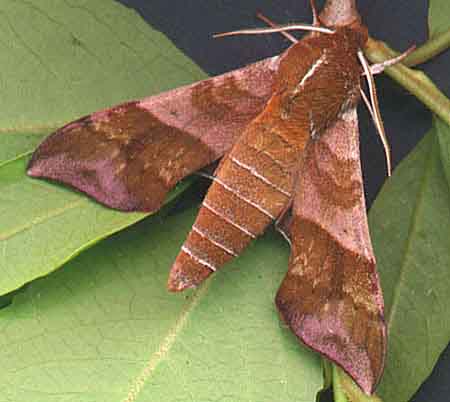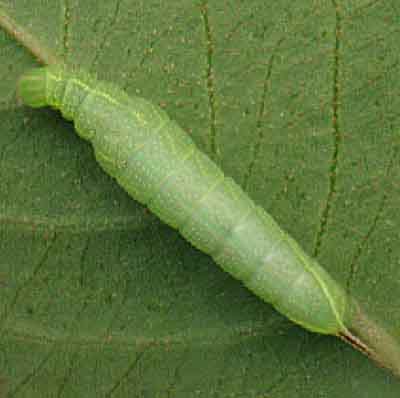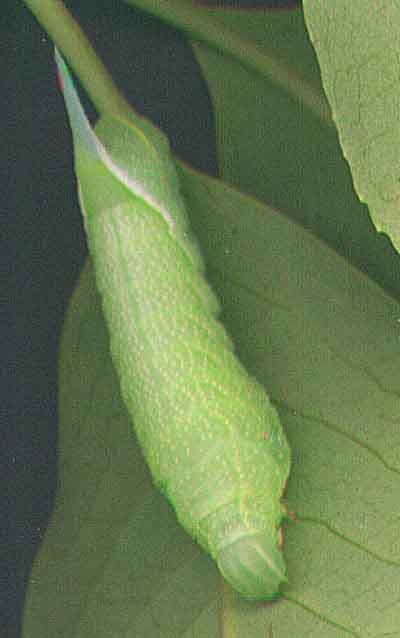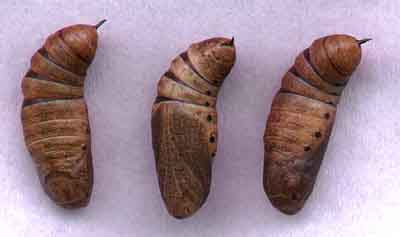Darapsa choerilus, the Azalea Sphinx
Darapsa choerilus
dah-RAP-suhmmchoe-RIH-lus
(Cramer, 1776)
Sphinx
Azalea Sphinx

Darapsa choerilus by Bill Oehlke
This site has been created by
Bill Oehlke at oehlkew@islandtelecom.com
Comments, suggestions and/or additional information/sightings are welcomed by Bill.
TAXONOMY:
Family: Sphingidae, Latreille, 1802
Subfamily: Macroglossinae, Harris, 1839
Tribe: Macroglossini, Harris, 1839
Genus: Darapsa Walker, 1856
Species: pholus (Cramer, 1776) |
MIDI MUSIC
.....It's a Wonderful World.....
copyright C. Odenkirk
ON.OFF
<bgsound src="world.mid" LOOP=FOREVER>
|
DISTRIBUTION:
The "Azalea Sphinx", Darapsa pholus
(now choerilus), ranges from south
eastern Canada to Florida westward to the Mississippi Valley. The
lower wings of this hawkmoth are a solid brownish-orange, matching
the body colour.
Visit Darapsa choerilus adult
Bradford County, Florida, courtesy of Edith Smith.
Visit Darapsa choerilus, Danby, Tompkins County, New York, June 2, 2013, Bill Evans
Visit Darapsa choerilus adult, Londonderry, Rockingham County, New Hampshire, June 26-28, courtesy of Deb Lievens.
Visit Darapsa choerilus larva, Lee County, Iowa, August 13-14, 2013; Thomas Jantscher
FLIGHT TIMES:In Canada, the single-brooded Darapsa choerilus adults fly in June and July.
Double-brooded stock in New Jersey begins its second flight period in July. Females (tongue length = 22mm) respond far
better to bait traps, but they also come in to lights. Once captured, the female hawkmoth will oviposit small green eggs on the
inside of paper grocery bags. No feeding is necessary.
Darapsa choerilus, Peterborough, Ontario, June 10, 2005, courtesy of
Tim Dyson.
|  |
In Louisiana there are as many as eight Darapsa choerilus broods beginning in March with emergence peaks at 30 day intervals.

Darapsa choerilus, Chatfield Park, Lee County, Iowa,
September 9, 2013, courtey of Thomas Jantscher.
ECLOSION:Darapsa choerilus larvae pupate in leaf litter at the base of the plant and emerge from
a flimsy cocoon of a few strands of silk holding the litter in place.
SCENTING AND MATINGFemales extend a scent gland from the posterior of the abdomen
to lure in the night flying males. I put my reared females in screened cages and introduce
wild males taken at lights. This hawkmoth mates readily and the couple remains paired until the
following evening.Darapsa choerilus, Peterborough, Ontario, June 10, 2005, courtesy of
Tim Dyson. |  |
EGGS, LARVAE, PUPAE:
Pale green, spheroid eggs are readily deposited on brown paper bags without feeding
of the females which come in to lights. The eggs incubate for 6-8 days depending upon
temperature, and larvae progress rapidly.
The extremely narrow head and neck (thorax) of this hornworm become evident in third instar. |
 |
The appetitites of these larvae increase dramatically
in the final instar and a sleeve of thirty of them can quickly defoliate several viburnum stems.
I prepare pupation buckets by filling bottoms with sun dried leaves to a depth of three inches.
Larvae are usually found near the bottom of the rearing sleeve, clinging to its sides, when
pupation is
imminent. They are easily pealed off remay and placed in the dark, covered buckets.
A loose cocoon, just a few strands of silk, is spun amongst the leaves and pupation occurs
within
3-4 days. LIVESTOCK of this species is available every fall.
|
 |
Darapsa choerilus pupae are very lively and wiggle using strong, jerky movements from side to
side when
disturbed, revealing dark brown colouring between the lighter abdominal segments. Dark brown
eyespots and
spiracles are also clearly visible on the pupal shell.
| 
|
These pupae will be stored in a cool, humid environment
(ziploc container with two drips of water on a few layers of paper tissue) from September til
May and June.
Larvae feed on Azalea and Viburnum and progress
very rapidly. Nyssa sylvatica (Black gum) is also listed as a host.
The larva Color change from green to light burgundy-brown indicating pupation is
imminent. Larvae descend plant stems to pupate in leaf litter near
the surface. Pupae are a light brown with dark brown abdominal intersegments.
I rear Darapsa choerilus outside on sleeved Viburnum cassinoides (image of fall fruit to left).
This is an understory shrub occasionally reaching
heights of twelve feet.
Most of the plants I encounter and use are five to eight feet tall. This plant also goes by witherod and wild raisin and
is easy to start from seed. I also use it for Hemaris thysbe, putting captured females in a six foot sleeve over some live stems.
When I see first larvae turn color, I usually bring the
remaining larvae indoors and let them eat cut food, i.e. branches severed from live plants, in plastic tubs.
Each morning I inspect tubs and lift out any larvae
that have changed color. These are placed in a bucket with about three inches of thoroughly dried leaves. The larvae crawl down through the leaves and fashion a
very flimsy cocoon out of a few strands of silk, used to bind several
leaves together.
Instead of using dried leaves, I now usually just place a folded, unscented paper towel in the bottom of a lidded plastic tub. The caterpillars do not seem fussy.

Darapsa choerilus, Louisiana, courtesy/copyright
Vernon Brou.
Visit Darapsa choerilus fifth instar on Viburnum, Washington County, Rhode Island, September 10, 2009,
courtesy of Ryan Saint Laurent.
Use your browser "Back" button to return to the previous page.
Goto Main Sphingidae Index
Goto Macroglossini Tribe
Goto Central American Indices
Goto Carribean Islands
Goto South American Indices
Goto U.S.A. tables
Enjoy some of nature's wonderments, giant silk moth cocoons.
These cocoons are for sale winter and fall. Beautiful Saturniidae moths will emerge the following spring and summer.
Read Actias luna rearing article. Additional online help available.
Use your browser "Back" button to return to the previous page.
This page is brought to you by
Bill Oehlke and the
WLSS. Pages are on space rented from Bizland. If you would like
to become a "Patron of the Sphingidae Site", contact Bill.
Please send sightings/images to Bill. I will do my best to respond to
requests for identification help.
 | 
Show appreciation for this site by clicking on flashing butterfly to the left.
The link will take you to a page with links to many insect sites. |









